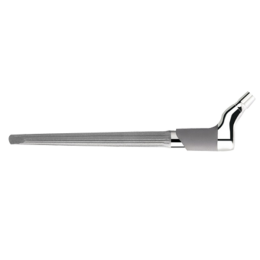Product Description
Proximal support of the implant is desired in all femoral revision hip surgeries. However, when the surgeon is unable to obtain proximal implant support, the ZMR XL Hip System should be considered. The ZMR XL Hip System was specifically designed to accommodate cases in which proximal support is not obtainable with the standard junction components. However, as with any non-supported femoral stem, the patient would be warned of the increased risk of fatigue fracture of the stem even though a ZMR XL construct is used.1-9
References
- Emerson RH, Sanders SB, Head WC, et al. Effect of circumferential plasma-spray porous coating on the femoral osteolysis after total hip arthoplasty. J Bone Joint Surg. 1999;81-A;9:1291-1298.
- Bourne RB, Rorabeck CH, Burkart BC, et al. Ingrowth surfaces – plasma spray coating to titanium alloy hip replacements. Clin Orthop. 1994;298:37-46.
- Feighan JE, Goldberg VM, Davy D, et al. The influence of surfaceblasting in the incorporation of titanium-alloy implants in a rabbit intramedullary model. J Bone Joint Surg. 1995;77-A;9:1380-1395.
- Zweymuller KA, Lintner FK, Semlitsch MF. Biologic fixation of a press-fit titanium hip joint endoprosthesis. Clin Orthop. 1988;235:195-206.
- Lintner F, Zweymuller, Brand G. Tissue reactions to titanium endoprosthesis. J Arthroplasty. 1986;1;3:183-195.
- Michelinakis E, Papapolychroniou T, Vafiadis J. The use of a cementless femoral component for the management of bone loss in revision hip arthroplasty. Hosp for Joint Diseases. 1996;55;1:28-32.
- Hartwig CH, Bohm P, Czech U, et al. The Wagner revision stem in alloarthroplasty of the hip. Arch Orthrop Trauma Surg. 1996;115:5-9.
- Crowninshield RD, Maloney WJ, Wentz DH, et al. The role of proximal femoral support in stress development within hip prostheses. Clin Orthop. In press 2004;4(10).
- Data on file at Zimmer, Inc.
Indications
The ZMR Hip Prosthesis is indicated for cementless total hip arthroplasty in patients whose bone stock is of poor quality or inadequate for other reconstruction techniques as indicated by deficiencies of the femoral head, neck, or portions of the proximal femur. Arthroplasty should be performed only when more conservative methods of treatment have failed to provide symptomatic relief or when there is progressive disability.
Information for Use
Special instruments are available and necessary to assemble, disassemble, and accurately install the implant components.
Contraindications
Contraindications include:
- Use of this device when a less invasive procedure would be sufficient
- Skeletal immaturity
- Loss of abductor musculature in the affected limb
- Poor bone stock (e.g., steroid-induced metabolic bone disease)
- Poor skin coverage around the hip joint
- Neuromuscular disease (e.g., Charcot’s joint) in the affected limb






